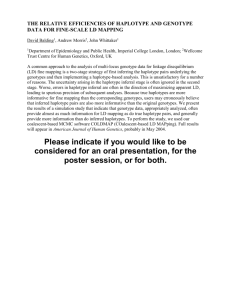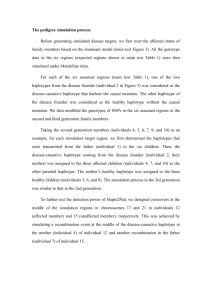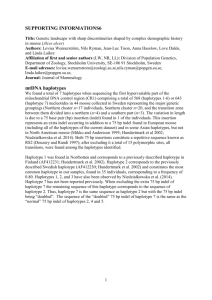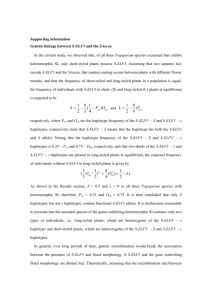Methods
advertisement
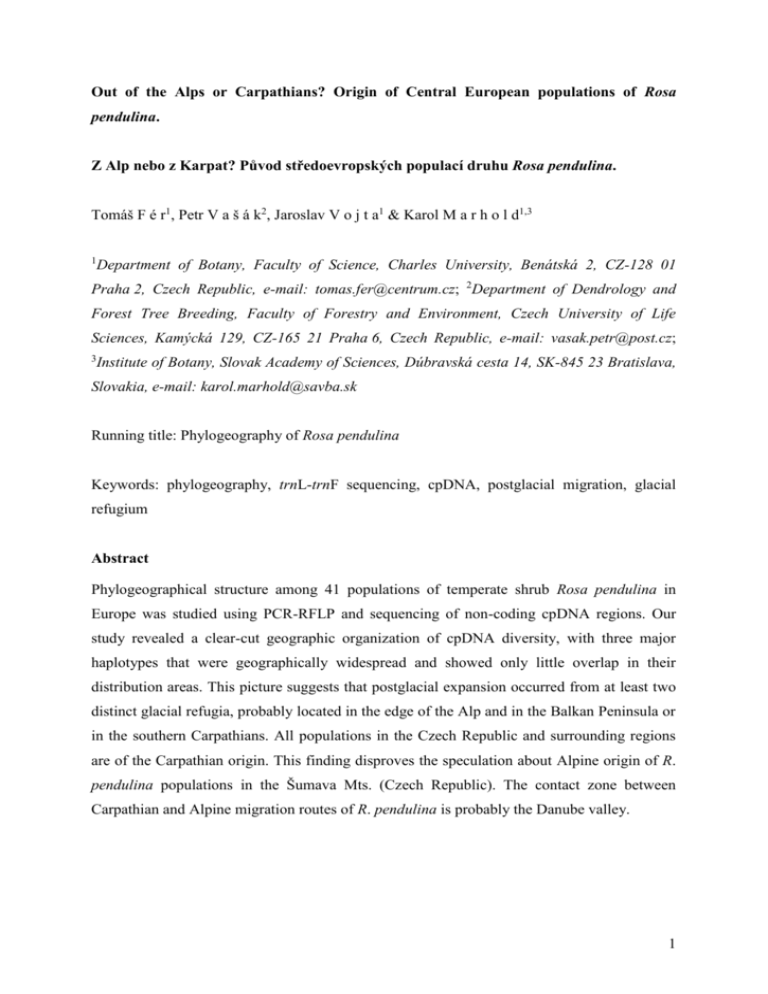
Out of the Alps or Carpathians? Origin of Central European populations of Rosa pendulina. Z Alp nebo z Karpat? Původ středoevropských populací druhu Rosa pendulina. Tomáš F é r1, Petr V a š á k2, Jaroslav V o j t a1 Karol M a r h o l d1,3 1 Department of Botany, Faculty of Science, Charles University, Benátská 2, CZ-128 01 Praha 2, Czech Republic, e-mail: tomas.fer@centrum.cz; 2Department of Dendrology and Forest Tree Breeding, Faculty of Forestry and Environment, Czech University of Life Sciences, Kamýcká 129, CZ-165 21 Praha 6, Czech Republic, e-mail: vasak.petr@post.cz; 3 Institute of Botany, Slovak Academy of Sciences, Dúbravská cesta 14, SK-845 23 Bratislava, Slovakia, e-mail: karol.marhold@savba.sk Running title: Phylogeography of Rosa pendulina Keywords: phylogeography, trnL-trnF sequencing, cpDNA, postglacial migration, glacial refugium Abstract Phylogeographical structure among 41 populations of temperate shrub Rosa pendulina in Europe was studied using PCR-RFLP and sequencing of non-coding cpDNA regions. Our study revealed a clear-cut geographic organization of cpDNA diversity, with three major haplotypes that were geographically widespread and showed only little overlap in their distribution areas. This picture suggests that postglacial expansion occurred from at least two distinct glacial refugia, probably located in the edge of the Alp and in the Balkan Peninsula or in the southern Carpathians. All populations in the Czech Republic and surrounding regions are of the Carpathian origin. This finding disproves the speculation about Alpine origin of R. pendulina populations in the Šumava Mts. (Czech Republic). The contact zone between Carpathian and Alpine migration routes of R. pendulina is probably the Danube valley. 1 Introduction Present distribution patterns of plants on the European subcontinent are to large extent determined by the extensive climatic changes during the Quaternary, which caused repeated cycles of species migrations throughout the continent (Hewitt 1999). Migration processes and the origin of the present distribution patterns can be inferred only indirectly, on the basis of palynological or, most recently, phylogeographical evidence. The latter deals with historical, phylogenetic components of spatial distribution of gene lineages (Avise 2000). The early phylogeographic studies of European taxa, dealing mainly with economically important trees (e.g., Alnus, Quercus, Fagus, King & Ferris 1998, Dumolin-Lapègue et al. 1997, Demesure et al. 1996), were focused on the determination of patterns on the whole continent scale. As a result, similar patterns of postglacial colonization routes were found for several taxa, and three main refugia in southern Europe were postulated (Iberian and Apennine Peninsula and the Balkans, see Taberlet et al. 1998). Cycles of area contraction and expansion strongly affected also patterns of genetic diversity. Putative refugial populations were found to harbour much higher diversity than populations in recolonized areas, which experienced bottlenecks during the expansion after warming 13,000 years ago (Comes & Kadereit 1998). Previous large-scale studies revealed several hybridization- or suture-zones (a term introduced by Remington 1968, for discussion see also Swenson Howard 2004) in Europe, where populations of the same or closely related taxa expanding from different refugia (Balkan, Apennine and Iberian) came into contact (Hewitt 1988, 1999, Taberlet et al. 1998). Although these suture-zones have not identical locations for all taxa, four main areas can be identified: the Pyrenees, the Alps, central parts of the Scandinavian Peninsula, and central Europe north of the Alps. Willis et al. (2000) and Willis & van Andel (2004) based on palaeoecological evidence concluded that there was no forestless landscape in Central Europe during the last glacial as hypothesized before. Thermophilous trees (Carpinus betulus, Quercus, Corylus, Ulmus and Tilia) must have survived in micro-environmentally favourable pockets in this area. Also recently published evidence on Fagus sylvatica (Magri et al., 2006) suggests the presence of open forests in Central Europe. This may considerably change the view on the origin of the Central European flora and postglacial migrations established by early phylogeographic studies. 2 When examining the present distribution patterns of taxa occurring in Central Europe north of the Alps, both Alpine and Carpathian migration routes can be suggested, but processes of postglacial migrations in this area are still not fully understood. The flora of the area of the Czech Republic provides an amount of examples of taxa with different patterns of postglacial immigration. In some cases it is possible to infer the postglacial origin of populations in a given area unequivocally from the present distribution pattern. Among them, a few examples of taxa with apparently Alpine origin are as follows: Soldanella montana (for distribution map see Slavík 1990), Alnus viridis (indigenous distribution, Kučera 1966, Plzáková 1973), Cardamine amara subsp. austriaca (Marhold, unpubl.) and Willemetia stipitata (Klášterský 1961, Kučera 1966), while Cardamine glanduligera (= Dentaria glandulosa; Slavík 1990, Lihová et al. 2007), Cardamine amara subsp. opicii (Hrouda & Marhold 1993), Centaurea jacea subsp. oxylepis and Salix silesiaca (both Hendrych 1985) most likely immigrated to the present area of the Czech Republic from the Carpathians. There is, however, an array of species that could have immigrated from both the Alps and Carpathians (Hendrych 1985). Some populations of these taxa can be unequivocally attributed to either the Alpine or Carpathian origin, based on present distribution pattern, while the origin of others (or even most of them) is uncertain. This phenomenon apparently reflects the existence of a suture-zone in the area of Central Europe, including the Czech Republic. One of the species for which both the Alpine and Carpathian postglacial immigration into the area of the Czech Republic can be hypothesized is Rosa pendulina. It occurs predominantly in mountains and hilly landscapes in the Alps, Carpathians, in the Balkan Mountains, the Apennines and in the Pyrenees (Meusel et al. 1965, Kurtto et al. 2004; Fig. 1). In the Czech Republic Rosa pendulina is common in mountains and hilly landscapes but it does not occur in lowlands (Slavík et al. 1995: 38, Větvička 1995). At least two migration routes into this area appear plausible, from the Carpathians in the east-west direction and from the Alps throughout the Šumava Mts. in the south-north direction, but available distribution data do not allow delimiting clear boundary between populations of these two migration routes (Hendrych 1985). In this study we analysed 41 samples of R. pendulina including populations from the whole distribution area of the species. Using sequencing of non-coding trnL-trnF region of cpDNA (widely used marker in phylogeographical studies; Taberlet et al. 1991) we searched for intraspecific variability which enabled us to define haplotypes of samples from the Central European region as well as the assumed refugia. The analysis allowed us to address following 3 questions: (1) Is there a phylogeographical structure in the distribution of cpDNA haplotypes? (2) Can we trace the origin of Central European populations? Which of the population from the potential refugia mainly contributed to the recolonization of Central Europe? (3) Are there any suture zones in Central Europe and where? (4) Is the postglacial spread of R. pendulina comparable to the pattern found in other species? Methods We analyzed individuals originated from 41 populations (one sample per population) from the whole distribution area, including hypothetical refugia (Pyrenees, southern Italy, the Balkans; Table 1). Young and healthy leaves were collected in the field and dried in silica gel. Voucher specimens have been deposited in the herbarium PRC (Charles University, Prague, Czech Republic). DNA extraction, PCR-RFLP and sequencing Total DNA was extracted using protocol of Doyle Doyle (1987) and dissolved in 1 TE buffer. DNA concentrations were measured photometrically and adjusted to 5 ng/l. We used two methods to define chloroplast DNA (cpDNA) haplotype of all individuals. First, we search for variability in three non-coding regions (psbC-trnS, trnK-trnK, trnC-trnD; Demesure et al. 1995) using polymerase chain reaction – restriction fragment length polymorphism (PCR-RFLP) approach. PCR reactions, containing 20 ng template DNA, 0.2 mM dNTP (Fermentas), 6 pmol of forward and reverse primer (Demesure et al. 1995), 2.0 μl 10× Buffer for RedTaq (Sigma), 0.5 U JumpStart REDTaq DNA Polymerase (Sigma), and water added to final volume of 20 l, were placed in a Mastercycler ep gradient S thermal cycler (Eppendorf). Reaction conditions were as follows: initial denaturation 1 min at 94 °C, followed by 35 cycles of 45 s at 94 °C, 45 s at 53.5–57.2 °C, 2–4 min at 72 °C with a final extension time 10 min at 72 °C (the exact annealing temperatures and elongation times depend on the amplified region; see Table 2 for details). PCR products were cut separately using 15 restriction enzymes as shown in Table 2. The restriction reactions contained 5.5 μl of PCR product, 2.0 μl corresponding restriction buffer (Fermentas), 9.0 μl ddH2O, and 3 U of restriction endonuclease (Fermentas). The digestions were performed for 4 h at 37 °C (HinfI, Hin6I, MboI, Bsh1236RI, AluI, BsuRI, MspI, RsaI, PstI, BglI, HincII) or 65 °C (TaqI, TaiI, 4 TasI, Tru1I). About 1 μl of 6× loading dye (Fermentas) was added to each tube after the restriction and the whole volumes of restriction products were loaded onto an 1.8% agarose gel and electrophoresed for approx. 1 hour using HU13 vertical electrophoresis unit (SciePlas). Fragments were visualized under UV light after ethidium bromide staining using Gel Logic 100 (Kodak) system and scored with the help of 1D Image Analysis Software (Kodak). Altogether, we searched for variability in restriction profiles among 11 populations from Romania (RP09), Ukraine (RP07), Slovakia (RP06), Austria (RP20), France (RP18), and Czech Republic (RP01, RP05, RP13, RP14, RP15, and RP17). Additionally, sequencing of trnL-trnF region of chloroplast DNA universal primers c and f by Taberlet et al. (1991) were used for amplification of the trnL intron and spacer between trnL and trnF regions in cpDNA. PCR amplification was carried out in a volume of 19 μl reaction using 5 ng of template DNA, 2 μl of 10 reaction buffer (Sigma), 0.4 μl of dNTP mix (10 mM), 4 pmol of each primer, and 0.5 U of REDTaq DNA Polymerase (Sigma). The reaction was optimized on a Mastercycler ep gradient S thermal cycler (Eppendorf) as one cycle denaturation at 94 °C, 35 cycles of 45 s denaturation at 94 °C, 45 s annealing at 52.2 °C, and 2 min extension at 68 °C, followed by 10 min extension at 70 °C. Amplification fragments were subsequently purified using JetQuick PCR Purification Kit (Genomed). Sequencing reactions were performed using BigDye Terminator v3.1 Cycle Sequencing Kit (Applied Biosystems) according to the manufacturer’s instructions. For sequencing of both strands the same primers were used. Purification of sequencing reactions followed the ethanol/sodium acetate precipitation protocol provided with the sequencing kit. Products were resolved on an ABI 3100 Avant automated sequencer (Applied Biosystems). Data analysis Sequences from both strands were manually assembled in one consensus sequence. All sequences were automatically aligned using ClustalX v 1.83 (Thompson et al. 1997). The resulted alignment was improved manually. Informative insertions/deletions were coded using the “simple indel coding” approach following the rules by Simmons Ochoterena (2000) as implemented in SeqState (Müller 2005). To reconstruct relationships among haplotypes, statistical parsimony network of haplotypes (Templeton et al. 1992) have been constructed using TCS 1.21 (Clement et al. 2000). This software construct a haplotype network in that the required number of mutational 5 steps leading from one haplotype to another is minimized. Moreover, the position of a haplotype in a network implies information regarding its age. Older haplotypes are thought to have a greater likelihood of being located internally in the network (Posada & Crandall 2001). The gaps were treated as missing data, but with additional indel coding (see above). Results We found no variability in cpDNA among 11 individuals from 11 populations using PCRRFLP approach. The combinations of cpDNA non-coding regions and restriction endonucleases that were used for searching of polymorphism are in Table 2. We sequenced the trnL-trnF region in 41 individuals from 41 populations (Table 1). Total length of the whole aligned region was 832 bp from which eleven positions were variable. We found nine point mutations and two length differences (one and four bp, respectively). Based on this variability five unique haplotypes can be recognized (A –E; Table 3). The DNA sequences were submitted to the GenBank database (one locality per each haplotype, accession numbers: haplotype A XXX, B XXX, C XXX, D XXX, E XXX). Three haplotypes (A, C, and D) are widely distributed, two additional haplotypes (B and E) occurred only locally. The geographical distribution of haplotypes is shown on the Fig. 2. Haplotype A occurs in the Balkans, in the whole Carpathians and in all analysed populations from Central Europe north of the Alps. Haplotype B was found only in one population from the Jeseníky Mountains (Czech Republic). The distribution of haplotype C includes Pyrenees, southern Italy and the western Balkans. All populations of R. pendulina in the Alps and surrounding area have haplotype D. Haplotype E was found only in one Bulgarian locality, namely in the Rila Mts (RP29). Relationships among haplotypes were determined constructing statistical parsimony network (Fig. 3). The input file includes the alignment and insertion/deletion were coded as two additional characters using C for the insertion presence and A for the absence. The haplotypes A and B found in the Carpathians and in Central Europe north of the Alps differ only by one point mutation. Similarly, southern European haplotype C and the Alpine haplotype D also differ by one point mutation. These two groups of haplotypes (A and B; C and D) differ by two point mutations. Hence, a missing (unsampled or extinct) haplotype is suggested among these groups. The haplotype E, found in the Balkans only, is much more 6 distinct from all other haplotypes. It differs by five point mutations and two indels from both haplotypes A and C. Discussion Despite we analysed only 41 populations of R. pendulina (using sequencing of the trnL-trnF region) our study revealed a clear-cut geographic organization of chloroplast DNA diversity, with three major haplotypes that were geographically widespread and showed only little overlap in their distribution areas. Nevertheless, no variability within three other non-coding cpDNA regions have been found using PCR-RFLP approach. Assumed refugia Based on the results obtained, the present day distribution of cpDNA haplotypes in R. pendulina suggests that postglacial expansion was from two major refugia. The first was located in the Balkan Peninsula or somewhere in the Southern Carpathians. From here the migration to the whole eastern and Central Europe occurred. This is one of the most common scenarios for the colonization of the Central Europe as demonstrated for Fagus sylvatica (Magri et al. 2006) or Carpinus betulus (Grivet Petit 2003). The second refugium can be located somewhere on the southern edge of the Alps, in northern Apennines or in the Dinaric Alps. From here the species spread throughout the Alps and surrounding regions. Such refugial area is postulated also for Alnus glutinosa (King Ferris 1998), Fraxinus excelsior (Heuertz et al. 2004) or Abies alba (Konnert & Bergmann 1995). Although no evidence of common phylogeographic histories across Europe have been found among tens of species compared (Taberlet et al. 1998) the postglacial history in R. pendulina is most similar to the pattern found in Abies alba (Konnert & Bergmann 1995). Also in this species the geographical distribution of genetic variation (allele frequencies at isozyme loci in this case) indicates refugia in the Balkans and in Italy. We found a common haplotype for all three hypothetical southern refugia indicating a connection between Iberian, southern Italian and the Balkan populations of R. pendulina. This haplotype (C) probably did not contribute to the present-day genetic pool of the Central European populations. The distribution of haplotype C on both the western and eastern shore of the Adriatic Sea illustrating the connection between refugia in the Italian and the Balkan Peninsulas has been observed in common ash (Heuertz et al. 2004), oaks (Fineschi et al. 2002, 7 Petit et al. 2002) or ivy (Grivet Petit 2002). Identical haplotype found in these areas indicate some contact of populations from these regions during cold periods. Indeed, during the last glacial maximum the sea level was considerable lower and there was a contact of the Apennine and Balkan flora, especially in northern part of the Adriatic region (Frenzel et al. 1992, Adams 1997). The most genetically distinct haplotype E (five point mutations and two indels apart from both haplotypes A and C) was found in a single population in Bulgaria (RP29). A more detailed study will be necessary to evaluate the haplotypic diversity in the Balkan Peninsula; a potential taxonomic problem cannot be excluded as well. Many phylogeographical studies revealed high diversity in this region (e.g. Fagus sylvatica – Magri et al. 2006; Alnus glutinosa – King Ferris 1998) but in most cases only a single lineage participated on the postglacial colonization to the north. Nevertheless, the hypothesis about survival of R. pendulina in Central Europe during the last cold period in the light of results by Willis et al. (2000) and Willis & van Andel (2004) may not be completely rejected on the basis of our data. More variable molecular marker (like AFLPs; Vos et al. 1995) would be necessary to investigate present-day population structure that can preserve some indication of past processes as bottleneck or founder effect (citace). The suture-zone in the Central Europe The suture zone between Carpathian and Alpine migration of R. pendulina is probably the Danube valley. This fact can be related to the present day distribution gap between the continuous Alpine area and the Danube river in Germany and Austria (Haeupler & Schönfelder 1989, H. Niklfeld et al., unpublished) that might be associated with unsuitable ecological conditions at low elevations. An alternative explanation of this phenomenon could be the barrier of the Alps that prevented the northward expansion of populations isolated at the southern edge of the Alps. Hence, the migration from the Alpine refugium was slowed down compared to rapid expansion along the Carpathians, and the Šumava Mts. were colonized from the Carpathian source. It is likely that first populations colonizing a region can prevent the arrival of other ones because the space is already occupied (Taberlet et al. 1998). In spite of the existence of this clear-cut border between Alpine and Carpathian colonization, some migration over the Danube was detected. The Hochschwab (RP62) and Schneealpe (RP49) populations in central eastern Austria have the Carpathian haplotype A. Since we 8 analysed only limited number of populations the more comprehensive study is necessary to obtain detailed information about postglacial migration in this suture-zone and about the extent of haplotype mixing. Origin of populations in Central Europe north of the Alps Based on the geographical pattern detected in variability of cpDNA, all populations in the Czech Republic and surrounding regions are of the Carpathian origin and probably originated from the postglacial migration from the Southern Carpathian or Balkan refugia. This finding disproves the speculation about the Alpine origin of R. pendulina populations in the Šumava Mts. (Hendrych 1985). The landscape with lower altitudes along the Danube was probably an ecological barrier, which prevented the Alpine populations of R. pendulina from dispersal further to the north. One unique haplotype B was found in the Jeseníky Mountains (Czech Republic; RP01). It is derived from the common Carpathian haplotype A from which it differs by a single point mutation. This haplotype probably evolved recently or during postglacial recolonization of the Central Europe from the Carpathian refugium. The terminal position of the haplotype in the network is another indication of the recent haplotype age (Posada & Crandall 2001). Acknowledgements We thank to V. Machalová and E. Rejzková for the help with molecular work. We are indebted to K. Boublík (Praha), H. Dvořáková (Praha), J. Fér (Kutná Hora), L. Férová (Kolín), B. Frajman (Ljubljana), A. Kagalo (Lviv), M. Kolník (Bratislava), J. Kučera (Rychnov n. Kněžnou), J. Lihová (Bratislava), D. Reich (Wien), E. Rejzková (Praha), P. Schönswetter (Wien), M. Slovák (Bratislava), P. Stanimirova (Sofia), M. Stolařová (Praha), A. Tribsch (Salzburg), V. Zabloudil (Žďár n. Sázavou), T. Wohlgemuth (Birmensdorf), and other colleagues for the help with sampling of plant material and J. Lihová also for comments on the manuscript. This work was supported by the Grant Agency of the Czech Republic no. 206/04/0770 and the MŠMT project no. 0021620828. 9 Souhrn Použitím PCR-RFLP a sekvenování nekódujících úseků cpDNA byla studována fylogeografická struktura mezi 41 populacemi růže převislé (Rosa pendulina) v Evropě. Naše studie ukázala jednoznačné geografické uspořádání diversity chloroplastové DNA. Tři hlavní haplotypy jsou geograficky široce rozšířené a vykazují jen velmi male přesahy v distribuci. Tato situace svědčí o tom, že postglaciální kolonizace probíhala nejméně ze dvou odlišných glaciálních refugií, která byla lokalizována na jižním okraji Alp a na Balkánském poloostrově nebo v jižních Karpatech. Všechny populace v České republice a okolí jsou karpatského původu. Toto zjištění vyvrací spekulace o možném alpském původu šumavských populací R. pendulina. Kontaktní zóna mezi alpským a karpatským migračním proudem je pravděpodobně údolí Dunaje. References Adams J. M. (1997): Global land environments since the last interglacial. – http://www.esd.ornl.gov/ern/qen/nerc.html. Oak Ridge National Laboratory, Oak Ridge. Avise J. C. (2000): Phylogeography. The history and formation of species. – Harvard University Press, Cambridge. Clement M., Posada D. Crandall K. (2000): TCS: a computer program to estimate gene genealogies. – Molec. Ecol. 9: 1657–1660 Comes H. P. & Kadereit J. W. (1998): The effect of Quaternary climatic changes on plant distribution and evolution. – Trends Pl. Sci. 3: 432–438. Demesure B., Sodzi N. Petit R. J. (1995): A set of universal primers for amplification of polymorphic noncoding regions of mitochondrial and chloroplast DNA in plants. – Molec. Ecol. 4: 129–131. Demesure B., Comps B. & Petit R. J. (1996): Chloroplast DNA phylogeography of the common beech (Fagus sylvatica L.) in Europe. – Evolution 50: 2515–2520. Doyle J. J. & Doyle J. L. (1987): A rapid DNA isolation procedure for small quantities of fresh leaf tissue. – Phytochem. Bull. 19: 11–15. 10 Dumolin-Lapègue S., Demesure B., Fineschi S., Le Corre V. & Petit R. J. (1997): Phylogeographic structure of white oaks throughout the European continent. – Genetics 146: 1475–1487. Fineschi S., Taurchini D., Grossoni P., Petit R. J. & Vendramin G. G. (2002): Chloroplast DNA variation of white oaks in Italy. – Forest Ecol. Managem. 156: 103–114. Frenzel B., Pécsi B. & Velichko A. A. (eds.) (1992): Atlas of palaeoclimates & palaeoenvironments of the Northern Hemisphere. – Geographical Research Institute, Hungarian Academy of Sciences, Gustav Fisher, Budapest, Stuttgart. Grivet D. Petit R. J. (2002): Phylogeography of the common ivy (Hedera sp.) in Europe: genetic differentiation through space and time. – Molec. Ecol. 11: 1352–1362. Grivet D. Petit R. J. (2003): Chloroplast DNA phylogeography of the hornbeam in Europe: Evidence for a bottleneck at the outset of postglacial colonization. – Conservation Genet. 4: 47–56. Haeupler H. & Schönfelder P. (1989): Atlas der Farn- und Blütenpflanzen der Bundesrepublik Deutschland. – Ulmer, Stuttgart. Hendrych R. (1985): Karpatische Migrationen und Florenbeziehungen in den Tschechischen Ländern der Tschechoslowakei. – Acta Univ. Carol. - Biol. 3–4: 105–250. Heuertz M., Fineschi S., Anzidei M., Pastorelli R., Salvini D., Paule L., Frascaria-Lacoste N., Hardy O. J., Vekemans X. Vendramin G. G. (2004): Chloroplast DNA variation and postglacial recolonization of common ash (Fraxinus excelsior L.) in Europe. – Molec. Ecol. 13: 3437–3452. Hewitt G. M. (1988): Hybrid zones – natural laboratories for evolutionary studies. – Trends Ecol. Evol. 3: 158–167. Hewitt G. M. (1999): Post-glacial re-colonization of European biota. – Biol. J. Linn. Soc. 68: 87–112. Hrouda L. & Marhold K. (1993): The distribution of Cardamine amara subsp. opicii (Cruciferae) in the Sudeten mountains. – Preslia 65: 27–32. King R. A. & Ferris C. (1998): Chloroplast DNA phylogeography of Alnus glutinosa (L.) Gaertn. – Molec. Ecol. 7: 1151–1161. 11 Klášterský I. (1961): Florogenetické prvky Československa [Florogenetic elements of Czechoslovakia]. – Sborn. Nár. Mus. v Praze, Řada B, Přír. Vědy 16: 129–157. Konnert M. & Bergmann F. (1995): The geographical distribution of genetic variation of silver fir (Abies alba, Pinaceae) in relation to its migration history. – Plant Syst. Evol. 196: 19–30. Kučera S. (1966): Fytocenologický a fytogeografický rozbor vegetace Novohradských hor [Phytocoenological and phytogrographical analysis of vegetation of the Novohradské hory Mts.]. – Ms., depon. in Knihovna katedry botaniky PřF UK, Praha. Kurtto A., Lampinen R & Junikka L. (eds.) (2004): Atlas florae europaeae 13. – The Committee for Mapping the Flora of Europe and Societas Biologica Fennica Vanamo, Helsinki. Lihová J. , Kochjarová J. & Marhold K. (2007): Hybridization between polyploids Cardamine enneaphyllos and C. glanduligera (Brassicaceae) in the West Carpathians: evidence from morphology, pollen fertility and PCR-RFLP patterns. – Preslia (in press). Magri D., Vendramin G. G., Comps B., Dupanloup I., Geburek T., Gömöry D., Latalowa M., Litt T., Paule L., Roure J. M., Tantau I., van der Knaap W. O., Petit R J. Beaulieu J. L. (2006): A new scenario for the Quaternary history of European beech populations: palaeobotanical evidence and genetic consequences. – New Phytol. 171: 199–221. Meusel H., Jäger E. & Weinert E. (1965): Vergleichende Chorologie der Zentraleuropäischen Flora. – Fischer, Jena. Müller K. (2005): SeqState - primer design and sequence statistics for phylogenetic DNA data sets. – Appl. Bioinformatics 4: 65–69. Petit R. J., Csaikl U. M., Bordács S. et al. (2002): Chloroplast DNA variation in European white oaks: Phylogeography and patterns of diversity based on data from over 2600 populations. – Forest Ecol. Managem. 156: 5–26. Plzáková H. (1973): [Distribution maps of Alnus viridis in the Czech Republic]. – In: Hendrych R. (ed.), Phytokartogramme einiger Gebirgspflanzenarten der Tschechischen Sozialistischen Republik, Acta Univ. Carol. - Biol. 1971: 267–306. Posada D. & Crandall K. A. (2001): Intraspecific gene genealogies: trees grafting into networks. – Trends Ecol. Evol. 16: 37–45. 12 Remington C. L. (1968): Suture-zones of hybrid interaction between recently joined biotas. – Evol. Biol. 2: 321428. Simmons M. P. Ochoterena H. (2000): Gaps as characters in sequence-based phylogenetic analyses. – Syst. Biol. 49: 369–381. Slavík B. (1990): Fytokartografické syntézy ČR 2 / Phytocartographical syntheses of the ČR 2. – Botanický ústav ČSAV, Průhonice. Slavík B., Smejkal M., Dvořáková M. Grulich V. (eds) (1995): Květena České republiky [Flora of the Czech Republic], 4. – Academia, Praha. Swenson N. G. & Howard D. J. (2004): Do suture zones exist?. – Evolution 58: 23912397. Taberlet P., Fumagalli L., Wust-Saucy A. G. Cosson J. F. (1998): Comparative phylogeography and postglacial colonization routes in Europe. – Molec. Ecol. 7: 453– 464. Taberlet P., Gielly L., Pautou G. Bouvet J. (1991): Universal primers for amplification of three noncoding regions of chloroplast DNA. – Plant Molec. Biol. 17: 1105–1109. Templeton A. R., Crandall K. A. Sing C. F. (1992): A cladistic analysis of phenotypic associations with haplotypes inferred from restriction endonuclease mapping and DNA sequence data. III. Cladogram estimation. – Genetics 132: 619–633. Thompson J. D., Gibson T. J., Plewniak F., Jeanmougin F. Higgins D. G. (1997): The ClustalX windows interface: flexible strategies for multiple sequence alignment aided by quality analysis tools. – Nucleic Acids Res. 24: 4876–4882. Větvička V. (1995): Rosa L. - růže. – In: Slavík B., Smejkal M., Dvořaková M. Grulich V. (eds), Květena České republiky [Flora of the Czech Republic], 4: 206–233, Academia, Praha. Vos P., Hogers R., Bleeker M., Reijans M., Vandelee T., Hornes M., Frijters A., Pot J., Peleman J., Kuiper M. Zabeau M. (1995): AFLP – a new technique for DNA fingerprinting. – Nucleic Acids Res. 23: 4407–4414. Willis K. J., Rudner E. & Sümegi P. (2000): The full-glacial forests af central and southeastern Europe. – Quatern. Res. 53: 203213. 13 Willis K. J. & van Andel T. H. (2004): Trees or no trees? The environments of central and eastern Europe during the last glaciation. – Quatern. Sci. Rev. 23: 23692387. 14 Figures Fig. 1. – Distribution area of R. pendulina in Europe according to Kurtto et al. (2004) (shaded) and location of 41 populations used in the study. For detailed descriptions of the populations see Table 1. Fig. 1. – Geographical distribution of five cpDNA haplotypes detected in R. pendulina. The present day distribution is shaded (Kurtto et al. 2004). Fig. 2. – Statistical parsimony network showing the relationships among five cpDNA haplotypes detected in R. pendulina. The box sizes are proportional to the number of localities where the haplotype was found. 15

